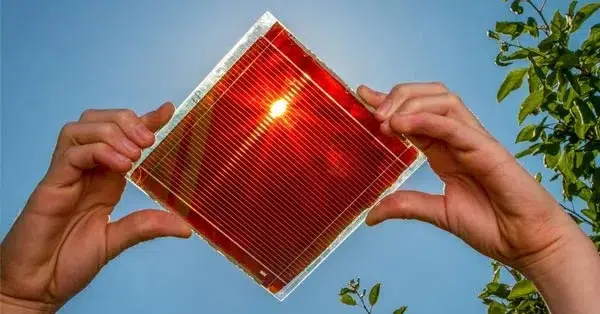
In addition, they would also be light solar panels, cheap to produce and as efficient as the main current photovoltaic materials, which are mainly silicon.
One of the last hurdles for solar cells made from perovskite to be commercially competitive is durability, but recently these transparent, flexible solar cells have achieved a lifespan of 30 years.
So, it’s time to learn about this new material, as it will likely be in the solar panels you’ll be choosing for your home in the very near future.
what is perovskite
The term perovskite does not refer to a specific material, such as silicon or cadmium telluride, other major competitors in the photovoltaic field, but to a whole family of compounds. The perovskite family of solar materials is named for its structural similarity to a mineral called perovskite, which was discovered in 1839 and is named after the Russian mineralogist Lev Alexeievich Perovski [1792-1856].
The original perovskite mineral, which is a calcium titanium oxide (CaTiO3), has a very peculiar crystal configuration: It has a three-part structure, the components of which are now labeled A, B, and X, in which the lattices of the different components are intertwined.
This interlocking lattice structure consists of charged ions or molecules, two of which (A and B) are positively charged and the other (X) is negatively charged. Ions A and B are usually quite different in size, with A being the largest.
Thus, the family of perovskites consists of the many possible combinations of elements or molecules that can occupy each of the three components and form a structure similar to the original perovskite itself.
“You can mix and match atoms and molecules in the structure, with some limits. For example, if you try to put a molecule that is too big in the structure, you will distort it. Eventually, you can make the 3D crystal separate into a structure of 2D layers, or lose the ordered structure altogether,” explains MIT professor Tonio Buonassisi. “Perovskites are highly tunable, like a ‘build your own adventure’ kind of crystal structure.”
Within the general category of perovskites, there are several types, including metal oxide perovskites, which have found applications in catalysis and in energy storage and conversion, such as fuel cells and metal-air batteries, which are considered the solution to electric vehicles.
But the fundamental focus of research for more than a decade has been lead halide perovskites (or lead halides).
Within this category, there is still a legion of possibilities, and laboratories around the world are competing in the tedious work of trying to find the variations that present the best performance in terms of efficiency, cost and durability, the latter being so far the most challenging of the three.
Many teams also focused on variations that eliminate the use of lead, to avoid its environmental impact. Professor Buonassisi notes, however, that “over time, lead-based devices continue to improve their performance steadily, and none of the other compositions have come close in terms of electronic performance.” Work continues to explore alternatives, but for now none can compete with the lead halide versions.
One of the great advantages offered by perovskites is their high tolerance to defects in the crystal structure. Unlike silicon, which requires extremely high purity to function well in electronic devices, perovskites can function well even with numerous imperfections and impurities.
Searching for promising new compositions for perovskites is a bit like searching for a needle in a haystack, but researchers have recently created a machine learning system that can greatly simplify this process. This new approach could lead to much faster development of new alternatives, said Buonassisi, who helped develop this system.
Although perovskites continue to show great promise and several companies are already preparing to start some commercial production, durability remains the biggest hurdle they face.
While silicon solar panels retain up to 90% of their energy after 25 years, perovskites degrade much faster.